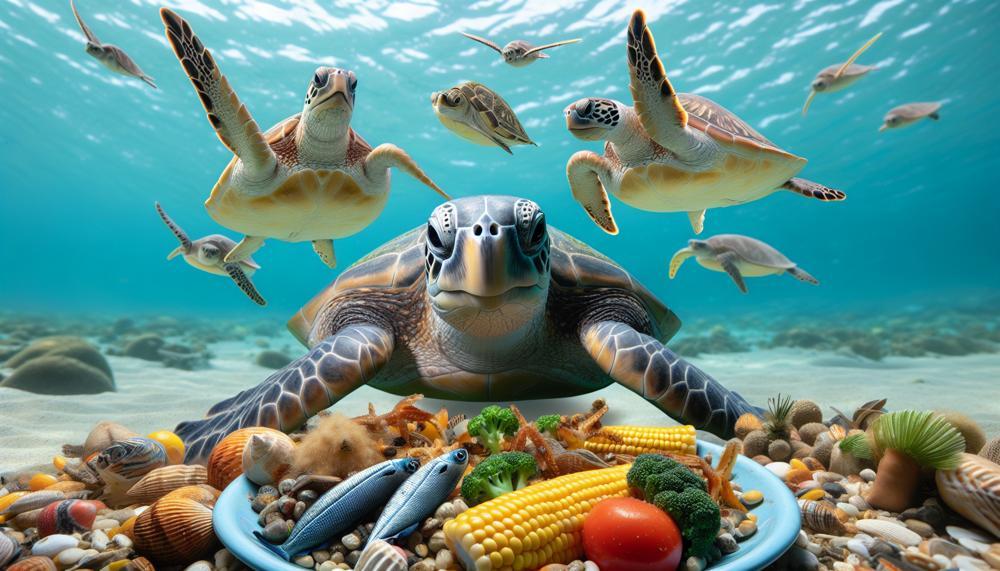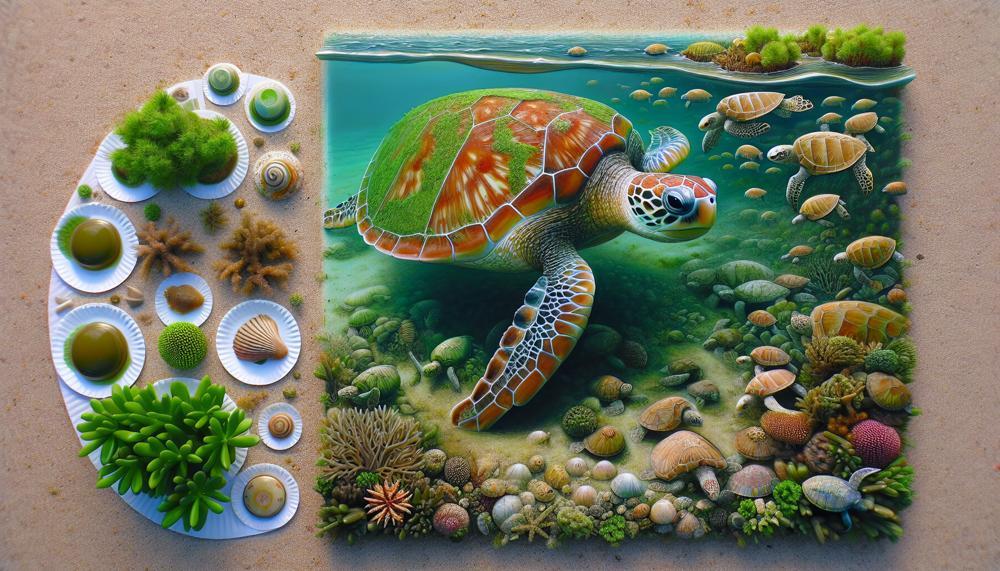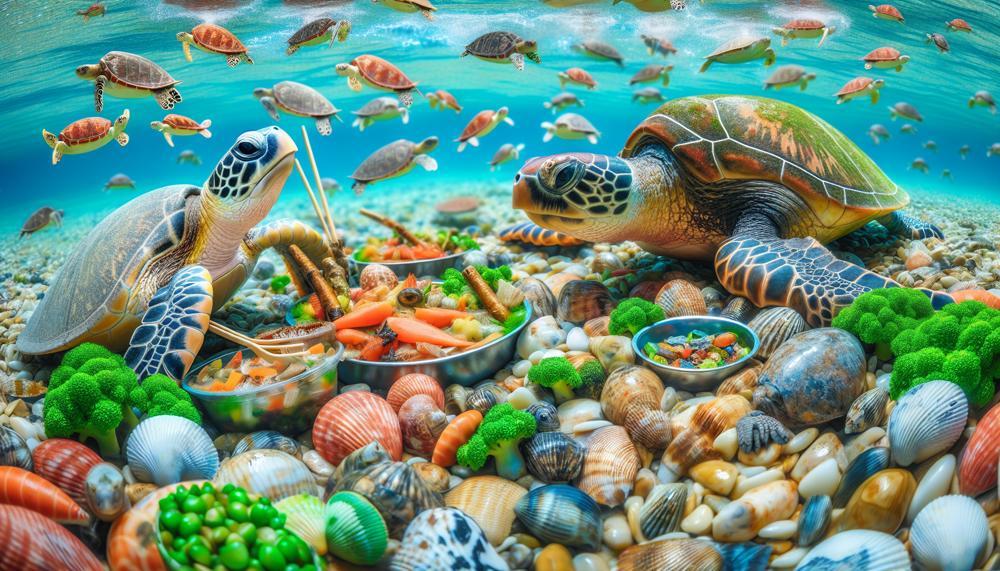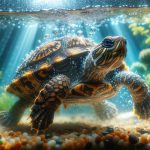Green sea turtles have been swimming in our oceans for over 100 million years, making them one of the oldest species on Earth.
And much like us, they have unique dietary requirements to thrive in their marine environment.
So, what exactly do these ancient reptiles feast upon? Let’s take a closer look:
- Green sea turtles are primarily herbivorous, meaning they predominantly consume plants and algae.
- With a specialized jaw structure, they effortlessly scrape off seagrass and seaweed from rocks and coral.
- These turtles can devour up to 2% of their body weight in food daily, which is quite impressive considering they can weigh over 400 pounds.
- Despite being herbivores, green sea turtles also supplement their diet with jellyfish, sponges, and even small fish.
- Their eating habits play a vital role in maintaining the health of seagrass beds and coral reefs, making them crucial for the overall balance of our ocean ecosystems.
Join us as we embark on an underwater journey to uncover the diverse and surprising dietary choices of green sea turtles. Trust us; this is one adventure you won’t want to miss.
Contents
- 1 What Do Green Sea Turtles Eat?
- 2 Understanding the Diet of Green Sea Turtles
- 3 Hatchling Diet: What Do Baby Green Sea Turtles Eat?
- 4 How Does the Diet of Green Sea Turtles Change as They Grow?
- 5 The Importance of Seagrass in the Diet of Green Sea Turtles
- 6 Other Foods in the Diet of Green Sea Turtles
- 7 The Unique Digestive System of Green Sea Turtles
- 8 Conclusion
What Do Green Sea Turtles Eat?
Green sea turtles have a diet that is primarily composed of seagrass and algae, with small amounts of animal matter. This plant-based diet is essential for their well-being and survival in the ocean.
In fact, it plays a crucial role in maintaining the overall health and balance of marine ecosystems.

| Life Stage | Diet | Percentage |
| Hatchlings | Invertebrates (such as sponges, jellyfish, and shrimp) | 100% |
| Adolescents | Diverse (including worms, crustaceans, and insects) | ~5% |
| Adults | Seagrass and algae | 95% |
| Occasional food sources | Small fish, crabs, and jellyfish | ~5% |
The green sea turtle’s unique digestive system allows them to thrive on this diet. They have a specialized stomach that can ferment seagrass and extract vital nutrients from it. This adaptation makes them highly efficient herbivores, contributing to their health and survival in the ocean.
The grazing behavior of green sea turtles also has a significant impact on marine ecosystems. By actively consuming seagrass, they help to maintain its balance, preventing overgrowth and promoting new growth. In turn, this benefits coral reefs and other habitats that rely on seagrass.
Aside from its nutritional value, seagrass also serves as a source of hydration for green sea turtles. As they consume it, they also ingest water, helping to keep them hydrated in the ocean.
Understanding the Diet of Green Sea Turtles
The diet of green sea turtles is essential for their survival and plays a crucial role in maintaining the health of marine ecosystems.
However, their diet can vary based on their age and location.
Let’s dive into the key types of food that make up the diet of these magnificent creatures.
Seagrasses:
Green sea turtles are known to graze on seagrasses using their serrated jaws.
These plants provide vital nutrients, energy, and essential vitamins to the turtles.
Algae:
Another important component of the green sea turtle’s diet is algae.
Young turtles rely heavily on this primary food source, while mature turtles use it as a supplement to their seagrass diet.
Vegetation:
Apart from seagrasses and algae, green sea turtles also consume other types of vegetation, such as seaweed, mangroves, and jellyfish.
These plants provide additional nutrients and diversify their diet.
Invertebrates:
While adult green sea turtles primarily feed on plant-based foods, young turtles have a more varied diet that includes invertebrates like worms, crustaceans, and insects.
Human-Induced Foods:
Unfortunately, human activities have led to an increase in the consumption of human-induced foods by green sea turtles. These include plastic bags that can be mistaken for jellyfish by the turtles, resulting in serious health issues.
To ensure the survival and conservation of green sea turtles, it is crucial to protect their natural habitats and reduce human impacts on their diet.
Hatchling Diet: What Do Baby Green Sea Turtles Eat?

| Food Source | Nutritional Value | Significance |
|---|---|---|
| Jellyfish | Low in calories, high in water content | Primary food source for baby green sea turtles, provides hydration and essential nutrients |
| Salps | High in protein, low in calories | Important source of protein for growth and development |
| Seaweed | High in fiber, vitamins, and minerals | Provides essential nutrients and roughage to aid digestion |
| Small Fish | High in protein, omega-3 fatty acids, and calcium | Provides essential nutrients for growth and development, supports bone health |
| Crustaceans | High in protein, calcium, and chitin | Provides essential nutrients for growth and development, supports molting process |
Furthermore, baby green sea turtles may also consume:
- Plankton: A source of essential nutrients and energy
- Mollusks: Provides calcium and other essential nutrients
- Sea urchins: Provides essential nutrients and roughage
How Does the Diet of Green Sea Turtles Change as They Grow?
As green sea turtles mature, their diet undergoes a significant transformation from a carnivorous one to an omnivorous or herbivorous one. This shift is a natural part of their growth and development process and is essential for their survival.
| Age | Diet | Notes |
| Juvenile | Carnivorous | – Feed on fish eggs, mollusks, jellyfish, small invertebrates, worms, sponges, and crustaceans. – Diet is diverse and mainly consists of animal prey. |
| Adult | Herbivorous/Omnivorous | – Mainly feed on vegetation such as seagrass and algae. – Some adult sea turtles may supplement their diet with animal prey. – Diet becomes more specialized towards vegetation as they mature. |
As green sea turtles grow from hatchlings to adults, their diet goes through a significant change. This transformation plays a crucial role in shaping their physical characteristics and ensuring their survival.
During their juvenile stage, green sea turtles primarily have a carnivorous diet. They consume a diverse range of animal prey, including fish eggs, mollusks, jellyfish, small invertebrates, worms, sponges, and crustaceans. This varied diet provides them with the necessary nutrients for healthy growth and development.
However, as they reach adulthood, green sea turtles shift to a mainly herbivorous or omnivorous diet. They feed on vegetation such as seagrass and algae. This change in diet is due to the natural growth process of these sea turtles.
Interestingly, some adult green sea turtles may still supplement their diet with animal prey, especially in areas with limited vegetation. This behavior is observed in sea turtles inhabiting such areas where they may not have access to a diverse range of plant-based food sources.
The Importance of Seagrass in the Diet of Green Sea Turtles
Seagrass is a vital part of the diet of green sea turtles. Not only does it provide key nutrients, but it also aids in digestion and contributes to their overall well-being.
In fact, it is estimated that seagrass makes up 50-80% of their diet, making it an essential food source for these majestic creatures. Seagrass is rich in fiber and contains vital nutrients that are crucial for the health of green sea turtles.
But that’s not all – seagrass also plays a critical role in the digestive process of these turtles. It contains symbiotic bacteria that help break down tough plant material, ensuring efficient digestion.
The benefits of seagrass extend beyond just providing food for green sea turtles. It also contributes to maintaining oceanic health by reducing erosion and improving water quality.
Seagrass beds act as nurseries for many marine species, including commercially important fish, making them essential for maintaining a balanced and sustainable marine ecosystem.
Other Foods in the Diet of Green Sea Turtles
The diet of green sea turtles goes beyond sea grass and algae. In fact, they also consume a variety of other foods that are essential for their growth and development. These include:
- Moss: Particularly in their early life stages, green sea turtles have been observed consuming moss. This plant is packed with nutrients and minerals that are crucial for the turtles’ health.
- Seaweed: Similar to algae, seaweed is a type of marine plant that green sea turtles also consume. It is rich in vitamins and minerals, making it a valuable food source for these turtles.
- Grasses: In areas where seagrass or algae is scarce, some green sea turtles have been known to feed on land grasses. This can be seen as an adaptation for survival when their preferred food sources are not available.
- Fish eggs: As a good source of protein and nutrients, juvenile green sea turtles may also feed on fish eggs.
- Hydrozoans, bryozoans, jellyfish, mollusks, worms, and crustaceans: As omnivores in their early life stages, green sea turtles will consume a variety of small marine animals for protein and nutrients.
- Sponges: Adult green sea turtles have been observed consuming sponges, which provide important minerals and nutrients for their diets.
- Insects: In certain areas, green sea turtles may supplement their diet with insects such as flies and beetles.
Overall, the diet of green sea turtles is diverse and includes both vegetation and marine animals. However, their preference for seagrass and algae means that their nutrition may not always be optimal.
This can lead to slower growth rates and potential health issues. Additionally, human activities like habitat destruction and pollution can affect the availability of these food sources, further endangering this species.
Green sea turtles are fascinating creatures with a unique diet. But as with any species, it’s important to ensure that their nutritional needs are met to promote their survival and well-being.
By understanding the various foods that make up their diet, we can better protect and preserve these magnificent creatures for future generations to admire and learn from.
The Unique Digestive System of Green Sea Turtles
The exquisite digestive system of green sea turtles plays a vital role in their ability to survive in their marine habitat. From their specialized diet to their mutualistic relationship with gut bacteria, every aspect of their digestive system is crucial for their survival. Let’s take a closer look at how each component of their digestive system enables them to thrive in their marine environment.
- Long, spiral-shaped esophagus with papillae: The green sea turtle’s esophagus is specifically designed to help them swallow and digest tough seagrass blades and other plant material. The elongated, spiral shape of their esophagus aids in moving food along and is lined with papillae, which assist in breaking down the food.
- Powerful stomach muscles and gastric juices: Once the food reaches their stomach, it undergoes further breakdown by powerful muscles and gastric juices. These juices contain enzymes that aid in breaking down the fibrous plant material and extracting essential nutrients.
- Large storage capacity in the stomach: Green sea turtles have the ability to store significant amounts of food in their stomachs, allowing them to survive for extended periods without food as they migrate to different feeding grounds. This adaptation has been observed in studies where green sea turtles were found to store up to 3% of their body weight in their stomachs.
- Long, spiral-shaped large intestine: Compared to other turtle species, the large intestine of green sea turtles is longer and has a spiral shape, similar to their esophagus. This provides more time for the food to be broken down and for essential nutrients to be absorbed.
- Symbiotic relationship with gut bacteria: Green sea turtles have a symbiotic relationship with gut bacteria that aids in breaking down tough plant fibers and producing essential vitamins and fatty acids that the turtles cannot produce on their own. This symbiosis is crucial for maintaining a healthy digestive system and overall well-being for these turtles.
- Impact on the ecosystem: The unique digestive system of green sea turtles also has a significant impact on their ecosystem. As they graze on seagrass, they play a vital role in maintaining the health of seagrass beds by preventing overgrowth and promoting nutrient cycling. This benefits other marine creatures that depend on seagrass for survival.
Conclusion
In conclusion, the diet of the green sea turtle is primarily comprised of seagrass and algae, with small amounts of animal matter.
This plant-based diet is crucial for their well-being and survival in the ocean as it provides vital nutrients and aids in digestion. As they mature, their diet shifts to mainly herbivorous or omnivorous, with a unique digestive system that allows them to efficiently process tough plant material.
Their long spiral-shaped esophagus, powerful stomach muscles, and symbiotic relationship with gut bacteria all contribute to this efficient digestion process.
Furthermore, their grazing behavior is essential for maintaining the health of seagrass beds and coral reefs, making them crucial for the overall balance of our ocean ecosystems.






